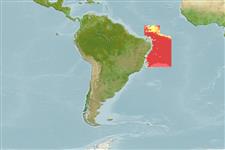>
Scombriformes (Mackerels) >
Chiasmodontidae (Snaketooth fishes)
Etymology: Pseudoscopelus: Greek, pseudes = false + Greek, skopelos = a lantern fish (Ref. 45335). Lütken did not recognize the presence of photophores on the body, confusing them with pores, but referred to a genus of lanternfish (Scopelus now Myctophum) when he named the genus (Ref. 85782).
More on author: Lütken.
Environment: milieu / climate zone / depth range / distribution range
Écologie
marin bathypélagique; profondeur 250 - 1370 m (Ref. 85782). Deep-water; 69°N - 20°S, 39°W - 23°W (Ref. 85782)
Western Atlantic, United States to Brazil, continental shelf and Islands of the Caribbean in the west to Central Atlantic. A tentative identification of a juvenile from off Nigeria (5º56’ N, 4º03’ E) extends the species range to the Eastern Atlantic.
Taille / Poids / Âge
Maturity: Lm ? range ? - ? cm
Max length : 15.5 cm SL mâle / non sexé; (Ref. 13608)
Description synthétique
Clés d'identification | Morphologie | Morphométrie
Épines dorsales (Total) : 7 - 9; Rayons mous dorsaux (Total) : 19 - 22; Rayons mous anaux: 19 - 22; Vertèbres: 35 - 36. This species can be distinguished from other members of the Pseudoscopelus scriptus species group by a single character, anal-fin photophores (saf) not extending anterior to the level of anus (vs. extending anteriorly to level of or beyond anus). It is further distinguished from the other species by a set of characteristics: mesial series of premaxillary teeth in 3-4 rows (vs. single row in P. obtusifrons and P. pierbartus); mesial series of teeth in rows of 3-4 teeth gradually increasing of size from lateral to mesial (vs. in rows of 2-3 teeth, with internal row much larger than other teeth in P. cordilluminatus); total vertebrae 35-36, precaudal 18-19 (vs. 31, 14 in P. cephalus);pigmentation in the internal part of mouth exclusive to a dusky area in the skin covering regions with teeth on premaxilla and dentary (vs. internal area of mouth and gill arches black in P. sagamianus ) (Ref. 85782).
A meso- to bathypelagic species found at 250-1,370 m (mean 786 m); juveniles to about 30.0 mm are known from 95 to 590 m (Ref. 85782).
Life cycle and mating behavior
Maturities | Reproduction | Spawnings | Egg(s) | Fecundities | Larves
Melo, M.R.S., 2010. A revision of the genus Pseudoscopelus Lütken (Chiasmodontidae: Acanthomorphata) with descriptions of three new species. Zootaxa 2710:1-78. (Ref. 85782)
Statut dans la liste rouge de l'IUCN (Ref. 130435)
Menace pour l'homme
Harmless
Utilisations par l'homme
Outils
Articles particuliers
Télécharger en XML
Sources Internet
Estimates based on models
Preferred temperature (Ref.
123201): 4.1 - 11.4, mean 9.9 °C (based on 8 cells).
Phylogenetic diversity index (Ref.
82804): PD
50 = 0.5000 [Uniqueness, from 0.5 = low to 2.0 = high].
Bayesian length-weight: a=0.00389 (0.00180 - 0.00842), b=3.12 (2.94 - 3.30), in cm total length, based on all LWR estimates for this body shape (Ref.
93245).
Niveau trophique (Ref.
69278): 3.7 ±0.2 se; based on size and trophs of closest relatives
Résilience (Ref.
120179): Milieu, temps minimum de doublement de population : 1,4 à 4,4 années (Assuming tmax>3).
Fishing Vulnerability (Ref.
59153): Low vulnerability (10 of 100).
